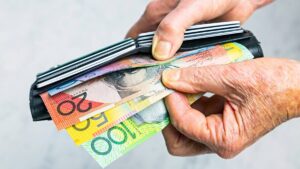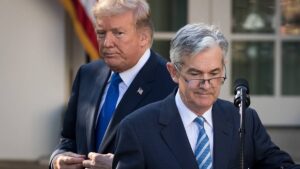Satisfaction if not excitement as Aussie GDP rises despite endless thwacking from RBA

Via Getty
Australia’s GDP grew by 0.4 per cent in the June quarter, according to the latest national accounts released by the Australian Bureau of Statistics (ABS) on Wednesday, slightly above forecasts of 0.3 per cent growth for the quarter.

The GDP drop comes inside the first 24 hours since the Reserve Bank of Australia (RBA) marked the departure of Governor P. Lowe by holding the Official Cash Rate (OCR) back for a third consecutive meeting.
Aussie mortgage holders were offered some relief. Interest rates haven’t been tweaked since the end of the bank’s 12 straight hikes and the official rate remains unchanged at 4.10%.
This month’s decision was the last dance for Lowe before handing the reins to deputy Michele Bullock.
On an annual basis, GDP growth was reported to have slowed to 2.1% in the 12 months to June, which was above economist forecasts for 1.8% growth.
Meanwhile, GDP per capita fell by 0.3% for the third consecutive quarter.
Katherine Keenan, ABS head of national accounts on the read:
“This was the seventh straight rise in quarterly GDP, and annual growth remained above trend, reflecting the absence of significant COVID-19 disruptions, such as lock downs, in 2022-23.
“Capital investment and exports of services were the main drivers of GDP growth this quarter.”
An excited Federal Treasurer Jim Chalmers got out in front of the read, these comments dropped about 30 seconds after the ABS release:
“The National Accounts show the Australian economy remaining sturdy in the face of unrelenting pressure.
“Economic growth held up relatively well in the June quarter, despite the inevitable toll of high interest rates, high but moderating inflation and continuing global uncertainty, including the slowdown in China.
“We know there are challenges ahead, but we face them from a position of relative strength.
The economy expanded by 0.4 per cent over the June quarter, matching the revised pace of the previous quarter, to be 2.1 per cent higher through the year. In the 2022‑23 financial year, the economy grew by 3.4 per cent.
“This is a steady result, but we know that households are under pressure from the rising cost of living and higher interest rates.”
Growing by just 0.1% in the last quarter, Aussie household consumption is moderating “in expected ways”, the Treasurer said.
Certainly, with the household saving ratio down to 3.2% – the lowest level since the GFC back in mid‑2008 – Australians appear to be controlling the urges around discretionary spend and instead focusing on the essentials and keeping some powder dry to cover mortgage repayments.
IG Markets’ Tony Sycamore says even in the face of the Reserve Bank’s 400bp of rate hikes since May, the solid GDP read reflects the Australian economy’s “continued resilience”:
“It eases (for now) fears around slowing in China, with Federal Treasurer Jim Chalmers – and also Tuesday’s RBA Statement – both highlighting the ‘uncertainty around the outlook for the Chinese economy’.
“While the RBA cash rate is widely thought to have reached its pinnacle at 4.10%, some fine tuning of monetary policy may still be required, before year end.”
Stressed out
Every second Aussie with a mortgage is “now under serious financial stress”, the financial comparison site Mozo.com.au reported yesterday, asking homeowners at what interest rates they’d feel “serious financial stress” – 46% said at around 5%.
Across all lenders in the Mozo database, the average variable rate for an owner-occupier home loan now sits at 6.60%, while the average variable rate for a Big Four bank home loan is 7.21%
“There were a number of ‘out of cycle’ rate rises in August putting more pressure on household budgets,” says Mozo’s money expert Rachel Wastell.
“Homeowners are now scrambling to find thousands more every month to cover the jump from 2 per cent rates just a year ago, to rates starting with 5%, 6%, and 7% today.”
Based on the average variable rate of 6.60% across all lenders in the Mozo database, monthly home loan repayments have now risen by more than $1,031 a month for Australians with a home loan of $500,000.
Prior to the GDP release, the AUDUSD was trading at .6370/72 and has since eased to a low of .6361 to be eyeing the overnight low of .6357 and weekly trendline support .6360/50.
Related Topics
UNLOCK INSIGHTS
Discover the untold stories of emerging ASX stocks.
Daily news and expert analysis, it's free to subscribe.
By proceeding, you confirm you understand that we handle personal information in accordance with our Privacy Policy.








